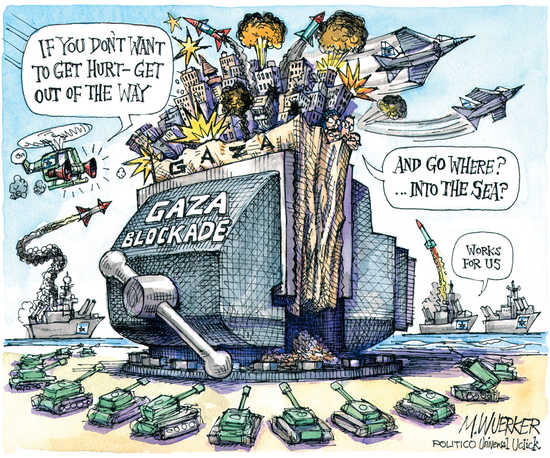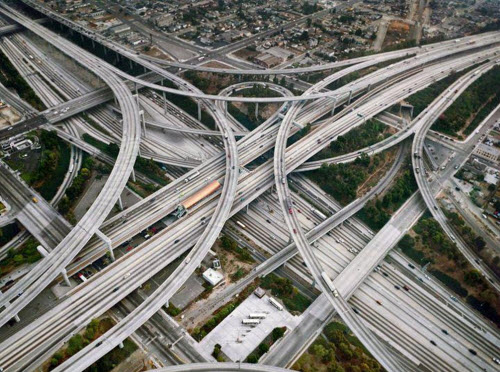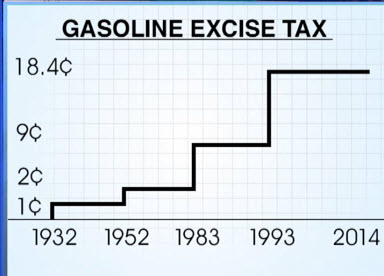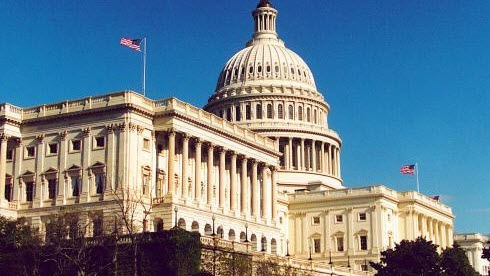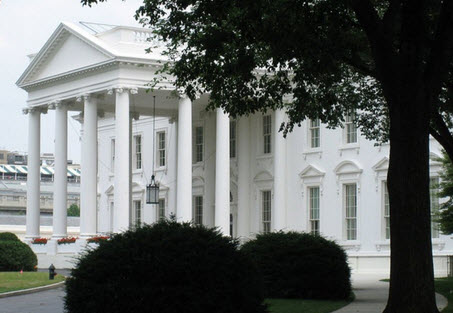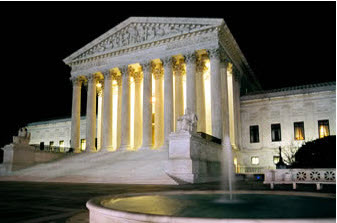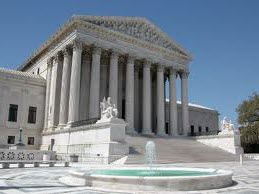Gaza: What the Media Doesn’t Report
When the air strikes began, Israel’s representatives in the U.S. fanned out across the talk shows to state that “Israel has the right to defend itself”, imprinting the phrase so successfully (Netanyahu’s envoy Ron Dermer has so far been accorded 55 interviews by the media) that we heard it repeated for days by television hosts and by Secretary of State John Kerry and the President, reaffirming his “strong support for Israel’s right to defend itself”.
Of course Israel has that right. But it seemed to lull the media, and the public in turn, into an expectation that defense was all that would happen rather than what was sure to come. You’d have thought from the coverage that Israel would just root out the tunnels along Gaza’s border and go home.
But “Israel is not a country upon which you fire missiles and it does not respond”, said Tzipi Livni, when Minister of Foreign Affairs. “It is a country that when you fire on its citizens it responds by going wild”. The periodic crippling of Gaza when it resumes its rocket attacks is referred to in Israel as “mowing the lawn”.
Our media seems unaware So when the Israeli Defense Forces (IDF) moved deeper into Gaza with relentless air strikes and artillery, American media’s shallow coverage made them late to realize that Israel was once again going well beyond defense and was set on destroying Gaza. Missing was reporting on what has happened before in this recurring conflict — and to excess.
The other under-reported subject has been the conditions in Gaza that led to Hamas’ desperate gamble.
history repeating
There have been three outbreaks — 2006, 2009 and 2012 — all in response to Hamas’ rocket attacks. The current conflict began when Israel launched airstrikes on Gaza in retaliation for the killing of three young Israelis, although they have no proof of Hamas involvement and it occurred in the West Bank to which Gazans have almost no access. Here again, you wouldn’t know that from the media, which almost universally speaks of Hamas casting the first stone.
The worst prior conflict began in December of 2008. Israel’s military objectives were accomplished swiftly, but the IDF then proceeded to demolish Gaza’s infrastructure. Approximately 1,400 Palestinians were killed in the assault and 13 Israelis.
A United Nations investigative commission produced a 574-page report that accused both Israel and the Palestinian militants of war crimes — Israel for its “policy” of deliberately killing civilians. Israel had refused to cooperate with the investigators and stridently rejected the report’s conclusions. Its lead author, Richard Goldstone, a South African judge, recanted some time later saying “civilians were not intentionally targeted as a matter of policy”. The other three authors angrily criticized Goldstone’s recantation as succumbing to outside pressure.
The findings of the remainder of the report are not in dispute. It said Israelis “wantonly” destroyed water and sewage facilities, called “systematically reckless” its use of white phosphorus (a fiercely burning incendiary that is extremely difficult to extinguish and meant only for camouflage smoke) and it documented that Israeli soldiers had used Palestinians as human shields. The report called Israel’s military assault on Gaza “a deliberately disproportionate attack designed to punish, humiliate and terrorize a civilian population, radically diminish its local economic capacity both to work and to provide for itself, and to force upon it an ever increasing sense of dependency and vulnerability”.
That, clearly, is happening all over again. It may seem that his time it’s different. This time leaflets, phone calls and even “taps on the roof “ — mini-bombs that say a real one is about to follow — have been employed to warn civilians to leave target areas. Except Israel did the same in 2009. And where can Gazans go, which we take up in this companion article.
the seven-year blockade
By lack of any mention, the media seemed ignorant of why Hamas had adopted their desperate plan. So public reaction asks why Hamas continues insanely to fire rockets only to bring havoc on its own people, as if stopping 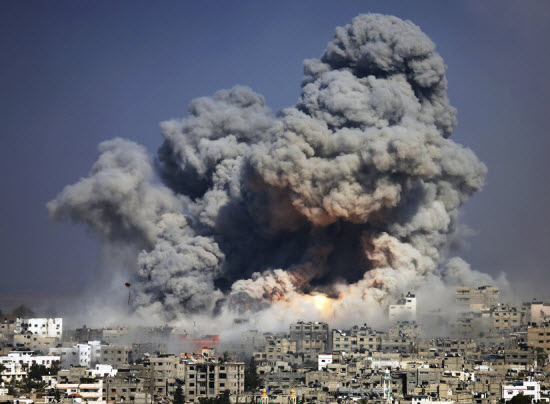
will restore a peaceful life to Gaza. Missing is the hatred Gazans hold for the Israelis that would become understandable if the media had devoted some time or space to this second under-reported story.
Only when a full two weeks after the beginning of hostilities the Hamas leader, Ismail Haniyeh, said they would not agree to a cease fire until Israel ends the blockade did the media wake up. “We cannot go back to the silent death of the blockade”, he said. “This unjust siege must be lifted”. The media only then began mentioning “the blockade”, but has explored it no further, nor do our politicians pay it much heed. Sen. Robert Menendez (D-NJ) referred to it as “what is called the blockade”, as if it might even be fictive. Netanyahu pretends innocence: “What grievance can we solve for Hamas? Their grievance is that we exist”.
Until 2005, Israel had occupied Gaza with military outposts and checkpoints in the same manner as in the West Bank. In a controversial move that year, Israel’s Prime Minister Ariel Sharon decided Gaza was not worth the bother. He withdrew the troops and 10,000 Israeli settlers. They had inserted themselves even into Gaza.
Instead of attempting to put together a fledgling state, Gaza chose conflict almost immediately, intermittently launching rockets and mortar fire. When Hamas won parliamentary elections in 2006, they fired fifteen rockets into Israel the day after a bomb killed seven members of a Palestinian family picnicking on a beach near Gaza City. Israel launched air strikes and over several months, 400 Gazans, six Israeli soldiers and four civilians were killed.
When Hamas took control in 2007, an alarmed Israel imposed a blockade — customarily considered an act of war in violation of Article 33 of the Fourth Geneva Convention — which has continued ever since. Israeli government officials have stated to aid organizations that their policy is a careful balance of “no prosperity, no development, no humanitarian crisis”.
![]() Palestinians in Gaza are locked in, unable to travel even to the West Bank, much less anywhere else, except a few by special permission. Their confinement is enforced at a single gate into Egypt on the south and three gates into Israel, two of which are closed. There were about 4,000 exits a month through the Erez gate into Israel last year, about 1% of traffic in 2000. Egypt has opened its border crossing on only 17 days so far this year.
Palestinians in Gaza are locked in, unable to travel even to the West Bank, much less anywhere else, except a few by special permission. Their confinement is enforced at a single gate into Egypt on the south and three gates into Israel, two of which are closed. There were about 4,000 exits a month through the Erez gate into Israel last year, about 1% of traffic in 2000. Egypt has opened its border crossing on only 17 days so far this year.
![]() The blockade was intended to bring economic activity to a halt. “The term ‘economy’ is no longer valid in the Gaza Strip,” says Palestinian economist Omar Shaban. Nearly 30% of Gaza’s businesses closed up shop and an additional 15% laid-off 80% of their staff, says Oxfam, the international federation that fights poverty. Unemployment runs around 50%. According to the U.N. about 70% of Gazans live on the equivalent of a dollar a day. Nearly 10% of children under five suffer from malnutrition; 65% of the population were suffering from food insecurity by the end of 2013; 80% depend on donor aid, according to OCHA, the U.N.’s humanitarian agency.
The blockade was intended to bring economic activity to a halt. “The term ‘economy’ is no longer valid in the Gaza Strip,” says Palestinian economist Omar Shaban. Nearly 30% of Gaza’s businesses closed up shop and an additional 15% laid-off 80% of their staff, says Oxfam, the international federation that fights poverty. Unemployment runs around 50%. According to the U.N. about 70% of Gazans live on the equivalent of a dollar a day. Nearly 10% of children under five suffer from malnutrition; 65% of the population were suffering from food insecurity by the end of 2013; 80% depend on donor aid, according to OCHA, the U.N.’s humanitarian agency.
![]() Israel and the West Bank constituted 80% of Gaza’s exports before the blockade, but they are now banned, as is the shipment of goods via Kerem Shalom in the south, Gaza’s only commercial transit point. Annual exports are about 3% of what they were before the blockade began. Flowers are about the only export item permitted by Israel under a special agreement with the Netherlands.
Israel and the West Bank constituted 80% of Gaza’s exports before the blockade, but they are now banned, as is the shipment of goods via Kerem Shalom in the south, Gaza’s only commercial transit point. Annual exports are about 3% of what they were before the blockade began. Flowers are about the only export item permitted by Israel under a special agreement with the Netherlands.
![]() The IDF maintains a buffer zone along the border half a mile wide, which puts off limits some 30% of the Strip’s arable land. Farmers report regular incidents of soldiers who guard the border shooting at them. Israel’s human rights group B’Tselem says that along the border about 55 civilians were injured on the border and four were killed in just the period between last December and March 2014.
The IDF maintains a buffer zone along the border half a mile wide, which puts off limits some 30% of the Strip’s arable land. Farmers report regular incidents of soldiers who guard the border shooting at them. Israel’s human rights group B’Tselem says that along the border about 55 civilians were injured on the border and four were killed in just the period between last December and March 2014.
![]() Almost no building supplies are allowed in — cement, glass, steel, plastic pipe crucial for reconstruction of thousands of buildings that were damaged or destroyed in the 2009 attacks — factories, government buildings, hospitals, schools, and entire neighborhoods. Israel fears that these materials could be used to build weapons or bunkers. Gaza’s own concrete plants were all bombed or bulldozed in Operation Cast Lead. The only building material is the rubble of destruction that boys pile onto donkey carts. Inability to build has caused a shortage of 230 schools, said a 2010 Oxfam report.
Almost no building supplies are allowed in — cement, glass, steel, plastic pipe crucial for reconstruction of thousands of buildings that were damaged or destroyed in the 2009 attacks — factories, government buildings, hospitals, schools, and entire neighborhoods. Israel fears that these materials could be used to build weapons or bunkers. Gaza’s own concrete plants were all bombed or bulldozed in Operation Cast Lead. The only building material is the rubble of destruction that boys pile onto donkey carts. Inability to build has caused a shortage of 230 schools, said a 2010 Oxfam report.
![]() Only about three dozen items can be brought in; the list changes frequently and has included at times computers, fruit juice, chocolate, coriander, cumin, jam, fishing rods — even included toys and paper for children’s textbooks. Speaking of children, Gazans compound their problems with a birthrate of 5.1 per woman, one of the world’s highest.
Only about three dozen items can be brought in; the list changes frequently and has included at times computers, fruit juice, chocolate, coriander, cumin, jam, fishing rods — even included toys and paper for children’s textbooks. Speaking of children, Gazans compound their problems with a birthrate of 5.1 per woman, one of the world’s highest.
![]() Restrictions on spare parts insures that what breaks stays broken, and that can include water and sewage treatment plants. Millions of gallons of raw or partially treated sewage flow into the Mediterranean daily for lack of fuel to operate treatment plants. Only 40% of Gaza’s fuel needs were being met last year causing blackouts of 12-16 hours. Gaza normally has electricity for barely eight hours a day, Israel having cut off what is almost all the electricity that comes into Gaza. Repairs by the water authority are now falling even further behind. The Times quoted a Gaza resident: “When the water comes back on,” he said, “the electricity goes off, and we can’t pump water to the roof tank.”
Restrictions on spare parts insures that what breaks stays broken, and that can include water and sewage treatment plants. Millions of gallons of raw or partially treated sewage flow into the Mediterranean daily for lack of fuel to operate treatment plants. Only 40% of Gaza’s fuel needs were being met last year causing blackouts of 12-16 hours. Gaza normally has electricity for barely eight hours a day, Israel having cut off what is almost all the electricity that comes into Gaza. Repairs by the water authority are now falling even further behind. The Times quoted a Gaza resident: “When the water comes back on,” he said, “the electricity goes off, and we can’t pump water to the roof tank.”
![]() This map by the Palestinian Academic Society for the Study of International Affairs is from 2007 but most of its features endure. It shows vividly the constraints on Gaza — the walls and gates that keep the Palestinians penned in. It particularly illustrates the fisheries blockade that prevents Gaza from feeding its own people. Oxfam reports that since 2008… Text continues below
This map by the Palestinian Academic Society for the Study of International Affairs is from 2007 but most of its features endure. It shows vividly the constraints on Gaza — the walls and gates that keep the Palestinians penned in. It particularly illustrates the fisheries blockade that prevents Gaza from feeding its own people. Oxfam reports that since 2008… Text continues below
…the sea blockade has reduced the main fishing catch — sardines — by 90%. Fishing yield is 7,000 metric tons lower than before the blockade.
![]() The Oslo Accords set a zone extending 20 nautical miles into the Mediterranean, but Israel’s IDF has unilaterally set its own limit, currently only three miles and sometimes a single mile. Even the six mile boundary cordons off the best fishing grounds. Gunboats patrol the waters and there have been incidents of their firing on fishing boats — 72 in 2011, for example. They often force the fishing boats ashore, arrest and interrogate fishermen. Israel completely controls Gaza’s air space (there is no airfield) and drones patrol the skies to enforce the fishing limits. “The fact that this coastal population now imports fish,” says a U.N. report, “speaks to the absurdity of the situation.”
The Oslo Accords set a zone extending 20 nautical miles into the Mediterranean, but Israel’s IDF has unilaterally set its own limit, currently only three miles and sometimes a single mile. Even the six mile boundary cordons off the best fishing grounds. Gunboats patrol the waters and there have been incidents of their firing on fishing boats — 72 in 2011, for example. They often force the fishing boats ashore, arrest and interrogate fishermen. Israel completely controls Gaza’s air space (there is no airfield) and drones patrol the skies to enforce the fishing limits. “The fact that this coastal population now imports fish,” says a U.N. report, “speaks to the absurdity of the situation.”
shut-ins
The Rafah crossing into Egypt is the only above-ground passage in or out of Gaza not controlled by Israel. The tunnels into Egypt were used were used to bring in arms, money, gasoline, cows, goats, building materials, even cars dismantled in Egypt and reassembled at the other end.
Access to Egypt was essential but Hamas is an offshoot of the Muslim Brotherhood. With Brotherhood ally Mohamed Morsi gone, President Abdel el- Sisi of Egypt has now closed the gate to Egypt and had hundreds of tunnels destroyed. Moreover, Hamas has been reliant on money and rockets from Iran by way of Syria, a link that was decoupled when they broke with President Bashar al-Assad over his fight against the Sunni insurgency in Syria. The seven-year blockade has made life nearly impossible, but these two developments have brought about desperation.
That is what explains Hamas’ gamble that if Israel can be induced to go too far once again, international pressure will insist this time on their lifting the blockade. So we now see Hamas gruesomely sacrificing hundreds of lives to this objective. Israel is of course concerned that it would merely allow Hamas to replenish its supply of rockets and has resorted to a humanitarian atrocity as the remedy. The United States, having made no demands for these seven years, is of course complicit. As the carnage mounts, it continues to support Israel while voices elsewhere shout “genocide”. And the facts of the blockade — the description of life in Gaza — is what goes unreported by the U.S. media.
A letter in the Times asked, “Would the United States respond any differently if hundreds of missiles were fired on its cities by terrorists?” A valid point — which leads to another. If Americans were penned into tight confines, disallowed from leaving, deprived of food, medicines, materials for building and commerce, children suffering from malnutrition, should Americans accept these conditions and not fight back?

